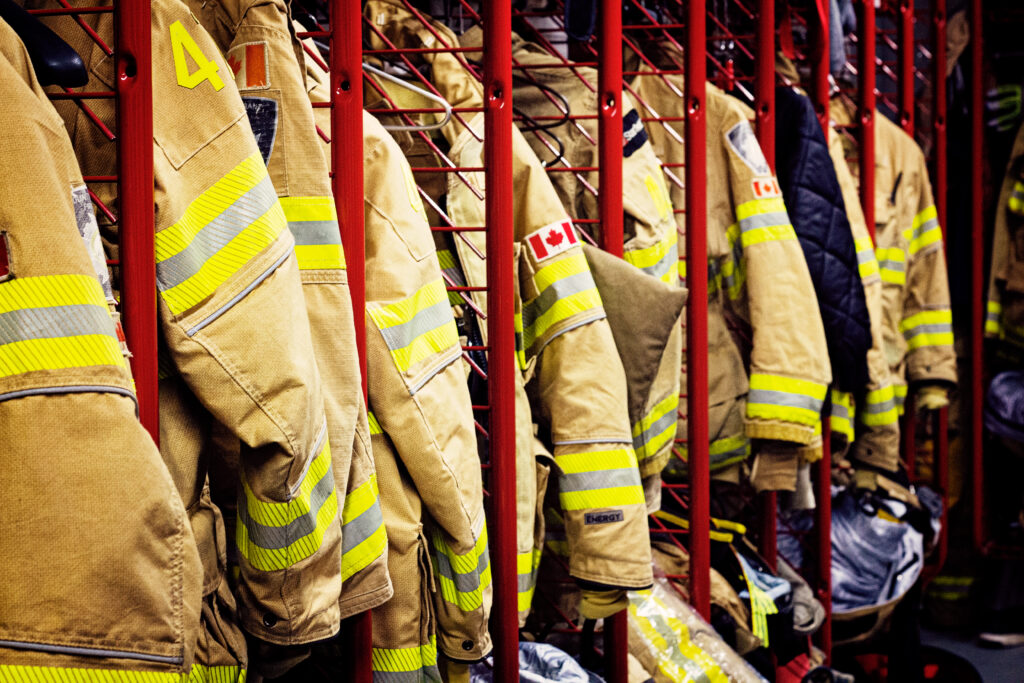
Headlines
News
New data captures a Canadian fire service in crisis
December 4, 2023
By FFIC Staff
 Close up shots of fire fighting equipment. Photo credit: Getty Images
Close up shots of fire fighting equipment. Photo credit: Getty Images Dec. 4, 2023, Canada – The results of the 2023 Great Canadian Fire Census are in, and the trends illustrate a growing threat to response capacity. Falling volunteer numbers, increasing call volumes, fiscal challenges, and firefighting’s reclassification into the top tier of carcinogenic jobs are some of the key factors putting on the pressure.
This is the third census produced by the Canadian Association of Fire Chiefs (CAFC) and reflects data submitted by 534 departments, including volunteer (61 per cent), composite (27 per cent) and career (12 per cent), representing all provinces and territories. There are 3200 nationwide and the CAFC used a specific methodology and calculations to extract a national dataset. The figures represent the 12-month period preceding April 1, prior to the start of wildfire season. The survey collected information on the number and type firefighters, service levels, call type and volumes, safety, gear and equipment, diversity and expenses.
“The unfortunate clarity of the fire crisis is knowing what needs to be done in service of safety, from installing a national fire administration to increasing the volunteer firefighter tax credit to replacing aging equipment, to implementing Firesmart principles, we just have to do it,” said Keven Lefebvre, chair of the CAFC Data Committee, and fire chief for Leduc County, Alta.
The census estimates found that, 9,500 volunteer firefighters, averaging 10 to12 years of experience, left the fire sector. Thirty per cent of firefighters are over the age of 50, broaching retirement soon. Just under 10,000 retired during the census period. Twenty-eight per cent of departments reported that their volunteer firefighters pay for out-of-pocket expenses such as mileage, gear, equipment, tools, gas and more. This was the first time the census collected this data, along with the estimate that 22 per cent of firefighters experienced violence or harassment on a call. Aging equipment or lack thereof is a concern for carcinogen exposure, with a washing machine absent in 21 per cent of halls, and 29 per cent using SCBA older than 15 years.
The number of female firefighters has stayed stable at 11 per cent against 2022 figures. Twelve per cent of positions are estimated to be vacant. When charting the number of volunteer firefighters over the years, NFPA data showed 126,000 in 2016 and the 2023 CAFC census shows 89,000.
In terms of equipment, 54 per cent deferred equipment purchases, up from 41 per cent in 2022. Twenty-four per cent of departments are operating with primary turn-out gear that is more than 10 years old, 62 per cent are using pumper fire trucks that are more than 15 years old, and 33 per cent of departments are operating tankers that are more than 20 years old. In 2022, a reported 800 fire trucks were needed. This figure jumped to 1381 in 2023.
“Fire sector equipment isn’t cheap, but the longer it deteriorates, the more difficult it is to replace. The former Joint Emergency Preparedness Program, cost shared with the provinces, is a mechanism to help keep the gap in check. Leadership is required to align all levels of government in addressing an issue that is as urgent as affordable housing and climate adaptation,” said Paul Boissonneault, co-chair of the CAFC Leadership Committee and fire chief in Oakville, Ont.
When it comes to types of calls, medical makes up 48 per cent. Ten per cent of calls were related to extreme weather events, and 10 per cent were for fire suppression. Thirty per cent were considered all-hazard (MVIs, hazmat, etc.). Notably, the 2022 study indicated that 44 percent of departments deferred training and equipment for more than two years due to finances, and that number went up to 54 per cent in 2023.
The CAFC will be taking this data to its annual Government Relations Week, running Dec. 4 to 7, when around 40 fire chiefs are expected meet with government officials. The mandate includes increasing the volunteer firefighter tax credit from $3,000 to $10,000 to retain volunteer firefighters, reinstating the Joint Emergency Preparedness Program to replenish the supply of equipment from fire trucks to radio communications, establishing a national fire administration to better coordinate, advise, lead and support the complexity of the fire situation in Canada, and funding FireSmart, critical infrastructure assessments and resilience plans in all communities to maximize resilience during wildfire season.
“We are asking the federal government to send a clear a message to this country’s firefighters – and to all Canadians in Budget 2024 – that they will stand shoulder to shoulder with us in ensuring the retention of essential personnel by increasing the volunteer firefighter and search and rescue tax credit. This is a realistic, affordable and necessary step to put Canada first as we approach the next wildfire season,” said CAFC president, Fire Chief Ken McMullen.
Read the full census report here.
Print this page
Advertisement
- Fire breaks out at homes under construction in Burlington
- Vancouver receives delivery of its first electric fire truck